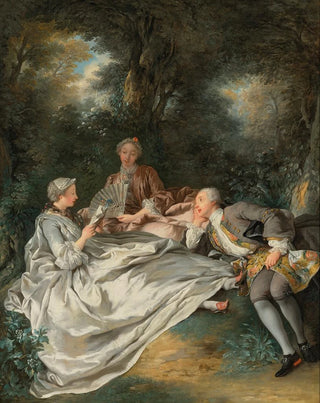Art print | La Fête de lecture - Jean-François de Troy


View from behind

Frame (optional)
In the vibrant universe of 18th-century art, the artwork "The Reading Party" by Jean-François de Troy stands out for its delicacy and intimate atmosphere. This painting, which depicts a scene of conviviality and intellectual exchange, invites the viewer to immerse themselves in a world where culture and beauty meet. The composition, both light and elegant, portrays characters absorbed in reading, creating a dynamic that transcends the simple act of reading. This piece embodies not only the spirit of the Enlightenment but also highlights the importance of education and literature in the society of the time. Through this work, the artist captures a moment of grace and reflection, offering a window into an era where critical thinking and appreciation of the arts were flourishing.
Style and uniqueness of the work
Jean-François de Troy's style is characterized by remarkable finesse and a keen sense of detail. In "The Reading Party," he employs a palette of soft colors that lends the scene a soothing and warm atmosphere. The characters, carefully dressed, are depicted in natural poses, demonstrating particular attention to anatomy and gesture. Light plays a crucial role in this piece, subtly illuminating the faces and clothing of the protagonists while creating delicate shadows that add depth to the composition. The carefully orchestrated staging invites peaceful contemplation, where every detail, from the book to accessories, contributes to the overall harmony. This painting does not merely depict a reading scene; it evokes a true celebration of knowledge, paying homage to the exchange of ideas and the importance of culture in daily life.
The artist and his influence
Jean-François de Troy, a French painter of the 18th century, established himself as a major figure of his time. Trained at the Royal Academy of Painting and Sculpture, he developed a unique style that combines classicism with modern sensitivity. His work is often characterized by a narrative approach, where each painting tells a story, engaging

Matte finish

View from behind

Frame (optional)
In the vibrant universe of 18th-century art, the artwork "The Reading Party" by Jean-François de Troy stands out for its delicacy and intimate atmosphere. This painting, which depicts a scene of conviviality and intellectual exchange, invites the viewer to immerse themselves in a world where culture and beauty meet. The composition, both light and elegant, portrays characters absorbed in reading, creating a dynamic that transcends the simple act of reading. This piece embodies not only the spirit of the Enlightenment but also highlights the importance of education and literature in the society of the time. Through this work, the artist captures a moment of grace and reflection, offering a window into an era where critical thinking and appreciation of the arts were flourishing.
Style and uniqueness of the work
Jean-François de Troy's style is characterized by remarkable finesse and a keen sense of detail. In "The Reading Party," he employs a palette of soft colors that lends the scene a soothing and warm atmosphere. The characters, carefully dressed, are depicted in natural poses, demonstrating particular attention to anatomy and gesture. Light plays a crucial role in this piece, subtly illuminating the faces and clothing of the protagonists while creating delicate shadows that add depth to the composition. The carefully orchestrated staging invites peaceful contemplation, where every detail, from the book to accessories, contributes to the overall harmony. This painting does not merely depict a reading scene; it evokes a true celebration of knowledge, paying homage to the exchange of ideas and the importance of culture in daily life.
The artist and his influence
Jean-François de Troy, a French painter of the 18th century, established himself as a major figure of his time. Trained at the Royal Academy of Painting and Sculpture, he developed a unique style that combines classicism with modern sensitivity. His work is often characterized by a narrative approach, where each painting tells a story, engaging






